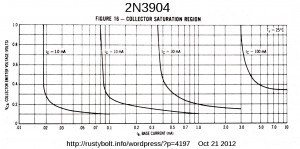Reasons to not use a 2N3904 in a Joule Thief or other high current circuit
 I’ve said this more than just a few times before: when used in a Joule Thief circuit, the 2N3904 is pushed beyond its ratings and gives below standard performance. The maximum ratings for the 2N3904 are 200 milliamps collector current, which is not enough for a conventional Joule Thief.
I’ve said this more than just a few times before: when used in a Joule Thief circuit, the 2N3904 is pushed beyond its ratings and gives below standard performance. The maximum ratings for the 2N3904 are 200 milliamps collector current, which is not enough for a conventional Joule Thief.
One might contend that going over the 200 mA maximum doesn’t really hurt the transistor. But the point isn’t that it might hurt something, the point is that going over puts the design into an area where the transistor was not designed to be, and the transistor will give poor performance. In the attached graph, the 2N3904’s collector current is shown with the line labeled Ic = 100mA. No matter how much the base current is, the line can’t get below 0.35V. At a collector current of 200mA, just guesstimating where the line would be is that the line would not go below a half volt. Let’s take the following theoretical example.
The JT circuit requires 250 milliamps peak current. The 2N3904 is turned fully on and the peak current climbs to 250 mA, but the voltage drop from collector to emitter is excessive, it climbs to 1/2 volt. So the transistor has 0.25 amp and 0.5 volt drop, and volts times amps equal power: 0.25 times 0.5 equals 0.125 watt, or 1/8 watt. The LED requires 20 mA at 3.2 volts for full brightness, and that equals 64 milliwatts. The 2N3904 is wasting about twice as much power as the LED requires!
By simply changing the 2N3904 to a 2N4401, PN2222A or BC337, the voltage drop collector to emitter will go down to 0.2 volt, and the wasted power will drastically decrease. The LED gets more power, the battery has to supply less power, and the circuit is no longer pushing the transistor past its maximum limit.
One of the marks of a good design is choosing the right components. The 2N3904 is not a good choice for a Joule Thief.
Back to experimenting…











